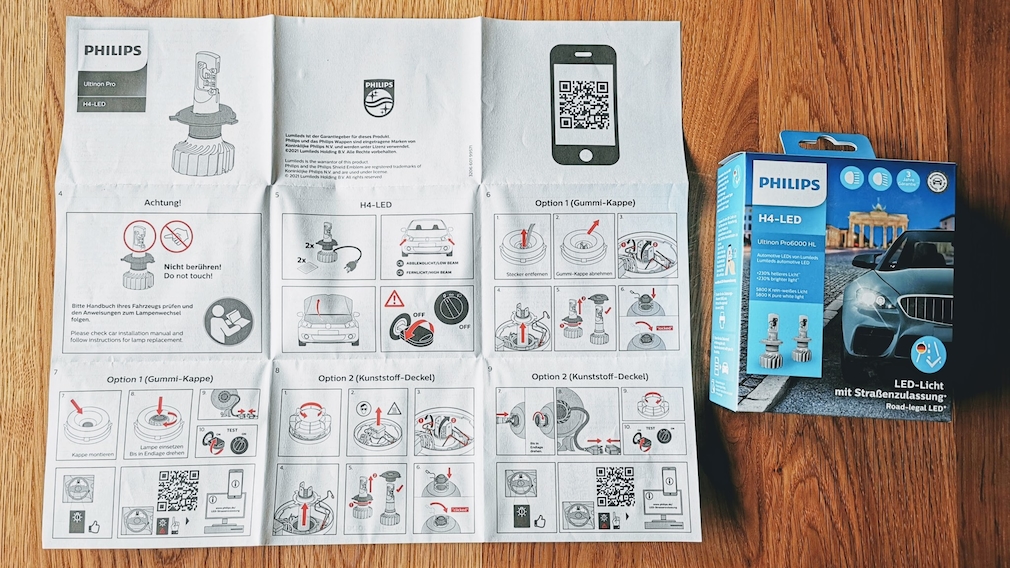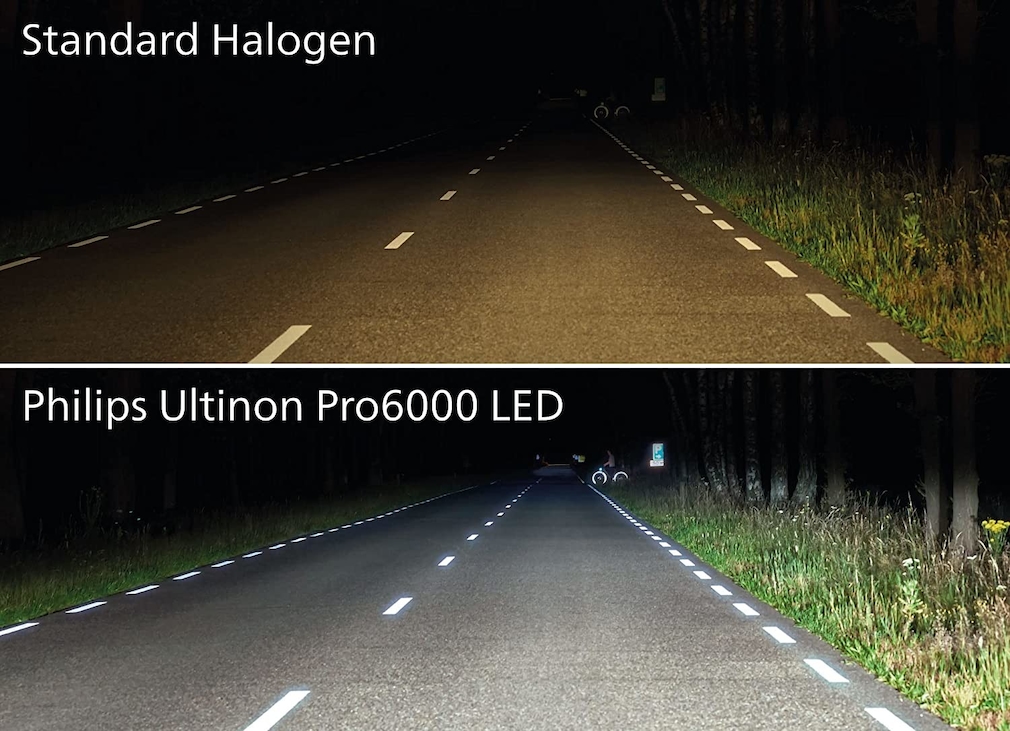Compared to halogen light, LED light has the advantage that it is much brighter. The lamps last longer and the light has a cold, modern-looking colour. LEDs that can be retrofitted have been around for a long time. But this is usually illegal and the matter is not a trivial offense: you can blind oncoming traffic. That’s why retrofit solutions for each vehicle and each headlight require an individual approval. So far there have been a whole range of vehicles with H7 lamps from Osram or Philips. With the Ultinon 6000Pro H4, Philips is now offering the first approved lamp for H4 headlights. COMPUTER BILD tried them out.
Not visible in the picture: On the Philips Ultinon Pro6000 H4 there is a cable about 15 cm long for the plug from the spotlight, which facilitates the connection if the lamp has found its place.
Philips Ultinon 6000Pro H7 LED on Amazon
Philips Ultinon 6000Pro H4 LED at Amazon
For selected vehicles only
Finally legal H4-LED in the VW e-up!
We have converted a VW e-up! tried out. VW has converted the combustion engine to electric drive and given it a modern LED light signature, but the main headlights have remained old H4 halogen lamps, which glow yellowish and therefore do not go with the LED saber tooth at all from an aesthetic point of view. There are halogen lamps that produce a particularly cold light, but that is just less yellow and not LED blue and white. Such a particularly white H4 was in the e-up! already installed. The difference when converting from standard lamps to LEDs is even more drastic than in the picture above.
Fiddly assembly without tools in the VW e-up!

The operating instructions provide information on installing the Philips Ultinon Pro6000 H4 in various vehicles.
If you know how to do it, assembly is not a problem. Basically, the old lamps come out and the LEDs in for them. You should avoid touching the glass body or the LED of the halogen and LED lamps because fingerprints will shorten their lifespan. The devil is in the details. Some vehicles also need an adapter so that there are no error messages. The e up! don’t need that. He offers another hurdle for this. Installation was as follows: 1. Pull the plug off the old lamp. 2. Unscrew the rubber seal. 3. Open wire clamp closure. 4. Remove the old H4 bulb from the bayonet catch by turning it a quarter turn and remove it. 5. Detach the carrier plate from the LED by turning it a quarter of a turn from the lamp. 6. Install the support plate in the headlight (you can check this from the front through the clear glass headlights) and lock it with the spring wires. The plate only fits in one position. 7. Put on the rubber seal.
Here was my mistake that made me sweat for 20 minutes and wondered if I shouldn’t cut some of the rubber gasket after all? No! Tip: The rubber seal not only has to be on the outside, you also have to press it firmly on the inside so that it docks exactly to the LED carrier plate. Otherwise you won’t get the LED lamp in deep enough. 8. Insert LED. Now it’s getting tight, because the lamp is larger than a standard halogen lamp due to the heat sink. You have to fiddle around a bit here. It fits better if you twist the lamp about 90 degrees. You thread the LED from behind through the rubber seal so that it slides into the front of the headlight far enough for you to snap the lamp into the bayonet catch. The LED is then fully upright. 9. Connect connector. And the whole thing again on the other side.
Legalize, verify, print out the ABG
To ensure that there are no problems during an inspection, you still have to do the paperwork. To do this, scan the QR code on the top of the packaging. You land on a Philips verification page. There you need to upload a photo of the packaging against a white background. It worked for us without any problems, but the verification with the message “Your product appears to be authentic” Then don’t specify. Why this cinnabar? Philips wants to make it more difficult to trade in counterfeit products. You will then receive the download link for the nine-page ABG (General Type Approval), which you must print out and carry with you.

Manufacturer’s photo illustrating the difference between halogen and LED.
Test conclusion: Philips Ultinon Pro6000 H4 LED
The installation is a bit fiddly, but with a little skill it can be done in a few minutes without tools. The effort is worth it! Both low beam and high beam are significantly brighter and appear much more modern. The illumination may sometimes not be quite as homogeneous as with standard LED lighting, but the increase in brightness is enormous. Safety and optics benefit from this. The price of just under 140 euros is reasonable for this and is put into perspective by the longer service life, which covers almost the life of a car. Purchase recommendation!
